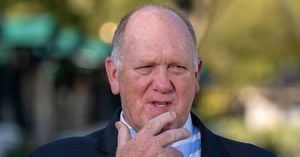The Bank of Russia has resolutely decided to keep its key interest rate at 21%, indicating a continued landscape of costly loans for borrowers. This marks the third successive meeting in which the central bank has opted to maintain this rate, a choice influenced by ongoing inflationary pressures. Experts believe, however, that rate cuts could be on the horizon as early as this summer.
According to the Bank of Russia, inflationary pressure is still prevalent, especially in stable segments of the economy. "The growth of domestic demand continues to significantly outpace the ability to expand the supply of goods and services. Meanwhile, credit growth remains subdued while the savings activity of households is high. The established rigidity of monetary and credit conditions creates the necessary groundwork for returning inflation to target by 2026," the central bank noted.
Forecasts suggest that the annual inflation rate could decrease to between 7% and 8% in 2025, with hopes of reaching the target of 4% by 2026. Despite some tightening of monetary policy beginning last July, Dmitry Golubkov, Director of Macroeconomic Analysis at OTP Bank, emphasizes a consistent increase in the volume of loans issued to individuals and legal entities until the end of 2024.
Recent data indicates a significant change in debt levels: between December 1, 2024, and February 1, 2025, corporate client debt reduced by 2.3%, while individual borrowers saw a 3.3% decrease in debt from November 1, 2024, to February 1, 2025. This suggests that current economic conditions might already be impacting borrowing behaviors.
Banking experts argue that for the lending market to rejuvenate, a reduction in the key rate is crucial. Vitaly Kostyukevich, the Director of the Retail Products Department at Absolut Bank, warns that mortgage market rates need to drop below 16% for the situation to improve significantly. He adds that a cut of at least 2 to 3 percentage points would be required for consumer loans and auto loans to stimulate demand effectively.
Furthermore, analysts from Gazprombank predict that the Bank of Russia is likely to begin lowering the key rate sometime this summer. They anticipate that during the meeting scheduled for June 6, the rate might decrease by as much as 200 basis points, potentially bringing it down to 19%. Looking towards the end of 2025, experts expect the rate might stabilize at around 14%.
Despite these expectations, any immediate changes to consumer loan conditions are likely to be made only gradually and by selected financial institutions. "While the regulator maintains the key rate, terms of consumer loans, auto loans, and mortgages will see only incremental adjustments by individual players in the market," notes Vladislav Fadeev, Director of the Analytical Department at the Gazprombank Economic Forecasting Center.
Moreover, the effect of maintaining the current rate is already evident in savings trends. Kostyukevich points out a shift in deposit rates, which have started to gradually decline. This change has enabled banks to reconsider mortgage rates, with some institutions even announcing reductions in certain loan products as they adjust to the new savings landscape.
The intriguing development in the discussions around home financing reveals that while market mortgage rates are anticipated to stay high, subsidized lending programs have gained traction. With an expansion of budget compensation for these loans, banks are reportedly more willing to issue preferential loans. Anna Zemlyanova, a senior analyst, notes that this trend is expected to persist, especially amid ongoing discussions about extending conditions around family mortgages announced by Russia's Ministry of Finance.
Nonetheless, the overall volume of mortgage issuance in 2025 could remain less than in 2024, according to leading analysts like Natalia Vashchylyuk. Despite some announcements of rate reductions by certain financial entities, the underlying factors affecting the mortgage market extend beyond just interest rates, as highlighted by Fadeev. He argues that the effective difference between a rate of 28% and 26% is negligible for most borrowers.
This reality constrains many potential buyers, particularly those who can only afford a down payment of roughly 20% of a home's value. For them, market mortgages will remain out of reach unless rates decrease significantly to the 12% to 15% range. Consequently, the sustainability of family and other subsidized mortgage programs become critical to many prospective homeowners.
As professionals in the sector weigh these elements, Kostyukevich cautions against rushing into loans. He suggests potential borrowers should monitor inflation trends and consider waiting until interest rates align more favorably. For significant loan applications, he recommends accumulating a larger down payment and placing funds into high-interest deposits while waiting for a rate drop between 14% and 16%. At that point, considering property purchase prospects might be more viable.
In this context, experts warn about the implications of high-interest rates and strict macroprudential regulations on borrowing. "Those with excessive debt burdens may find it increasingly difficult to secure loans, particularly as the Bank of Russia positions itself to impose macroprudential limits on mortgage and auto lending come April," remarks Alexei Okhorzin, Deputy President and Chairman of the Board of Post Bank. This illustrates the need for borrowers to realistically assess their repayment capabilities, especially since a re-financing opportunity may not arise for over a year.
Strategically, banks are projecting that the current key rate will remain high through the monetary policy tightening cycle. Anticipating a gradual easing starting in late 2025, forecasts by industry analysts suggest significant shifts could occur should the economic momentum support it. Ultimately, the future will depend on a balance between inflation control, economic recovery, and consumer borrowing capacities.





